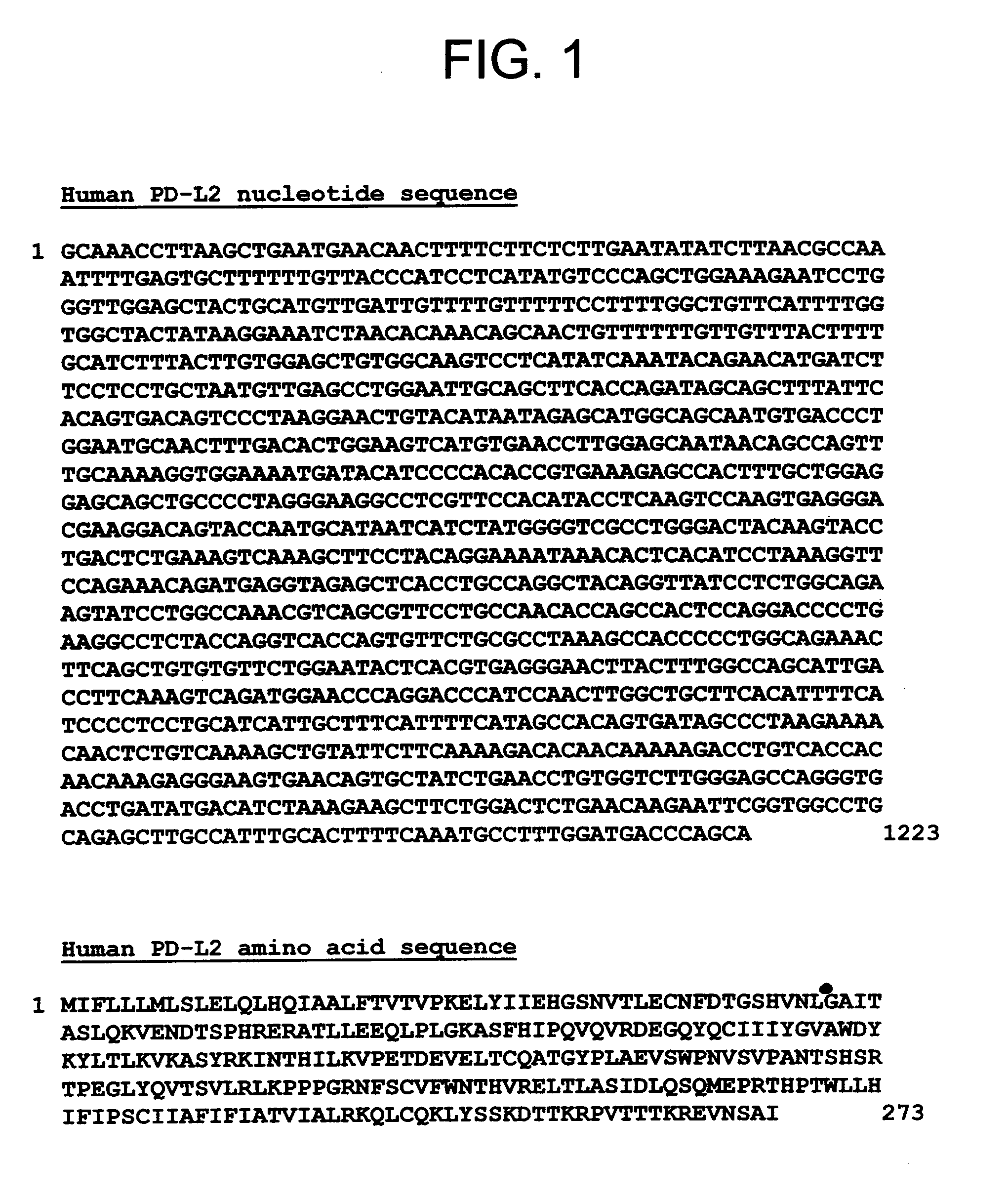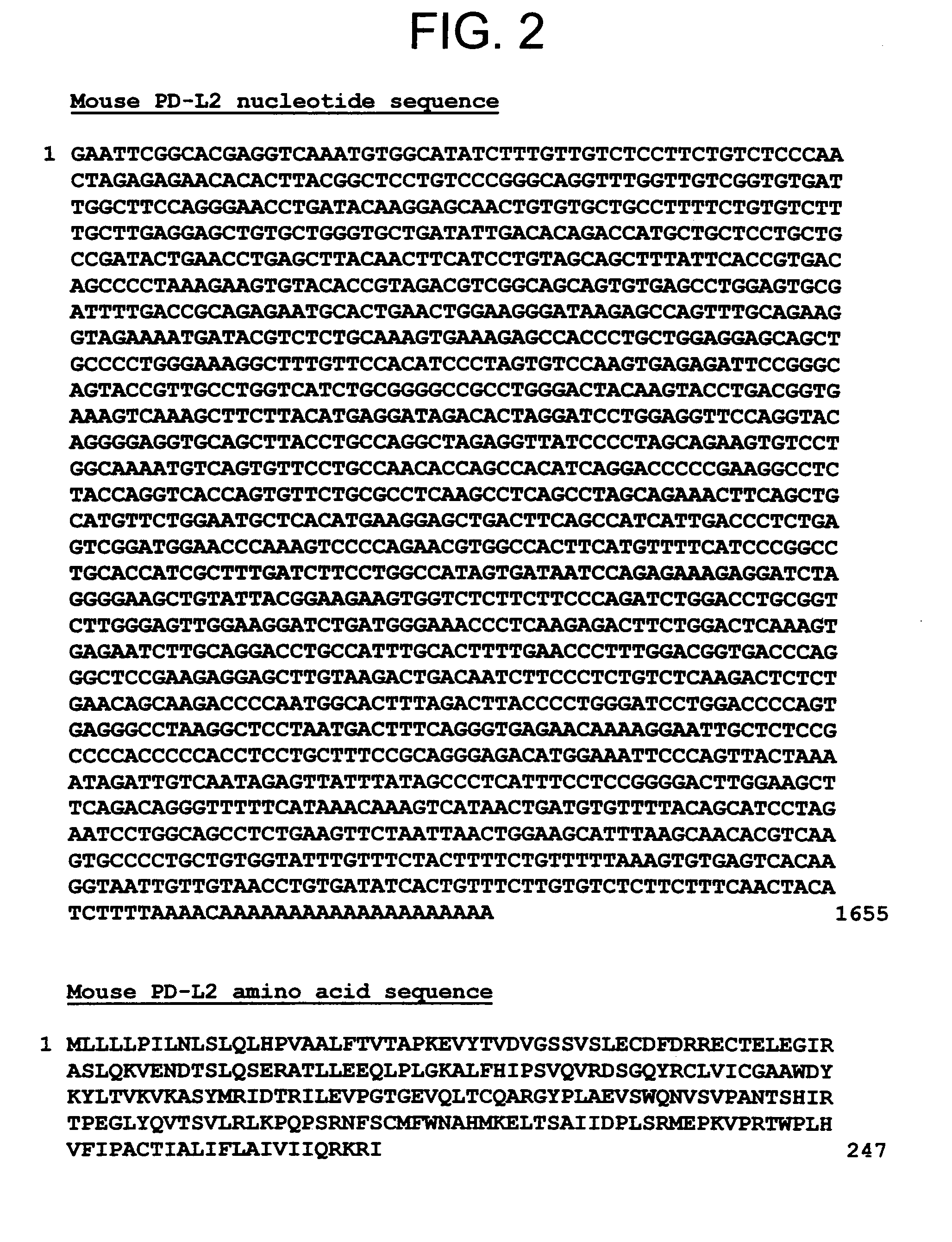PD-L2 Molecules: Novel PD-1 Ligands and Uses Therefor
a technology of pd-1 and pdl2, which is applied in the field of pdl2 molecules : novel pd1 ligands, can solve the problems of immune cell anergy, specific unresponsiveness, downmodulation of immune response,
- Summary
- Abstract
- Description
- Claims
- Application Information
AI Technical Summary
Benefits of technology
Problems solved by technology
Method used
Image
Examples
example 1
Identification and Characterization of Human and
[0385]Mouse PD-L2 cDNA
[0386]In this example, the identification and characterization of the genes encoding human PD-L2 and mouse PD-L2 is described.
[0387]Isolation of the human PD-L2 cDNA
[0388]The invention is based, at least in part, on the discovery of human genes encoding novel polypeptides, referred to herein as human PD-L2. The human PD-L2 cDNA was isolated from a human placental cDNA library using as a probe the human EST AA247117. The entire sequence of human PD-L2 was determined and found to contain an open reading frame termed human “PD-L2”
[0389]The nucleotide sequence encoding the human PD-L2 is shown in FIG. 1 and is set forth as SEQ ID NO:1. The polypeptide encoded by this nucleic acid comprises about 273 amino acids and has the amino acid sequence shown in FIG. 1 and set forth as SEQ ID NO:2. The coding region (open reading frame) of SEQ ID NO:1 is set forth as SEQ ID NO:3.
[0390]The nucleotide sequence encoding the mouse P...
example 2
Expression of Recombinant PD-L2 Polypeptide in Bacterial Cells
[0398]In this example, human PD-L2 is expressed as a recombinant glutathione-S-transferase (GST) fusion polypeptide in E. coli and the fusion polypeptide is isolated and characterized. Specifically, PD-L2 is fused to GST and this fusion polypeptide is expressed in E. coli, e.g., strain PEB199. Expression of the GST-PD-L2 fusion protein in PEB199 is induced with IPTG. The recombinant fusion polypeptide is purified from crude bacterial lysates of the induced PEB199 strain by affinity chromatography on glutathione beads. Using polyacrylamide gel electrophoretic analysis of the polypeptide purified from the bacterial lysates, the molecular weight of the resultant fusion polypeptide is determined.
example 3
Binding of PD-L2 to PD-1
[0399]COS cells were transfected with an expression plasmid containing AF142780, the mouse PD-L2 cDNA, or a control mouse PD-1 ligand. After 72 hours, the transfected COS cells were detached by incubation in PBS containing 0.5 mM EDTA for 30 min. at 37° C.
[0400]The ability of COS cells expressing PD-L2 to bind to various Ig fusion proteins was tested. FACS analysis of binding of IgG2a (control Ig), ICOS-IgG, and PD-1-Ig by PD-L2-tranfected COS cells showed that neither IgG2a or ICOS-IgG was bound by PD-L2 or the control PD-1 ligand. PD-1-Ig, however, was shown to bind to PD-L2 and to the control PD-1 ligand (FIG. 4).
[0401]Experiments using the human PD-L2 cDNA yielded results similar to those obtained using the mouse PD-L2 cDNA.
[0402]Experiments were also preformed using CHO cells. Flow cytometry studies indicate that hPD-1-Ig recognizes CHO cells stably transfected with PD-L2 (FIG. 7). This staining was specific, since there was no binding to control transfe...
PUM
| Property | Measurement | Unit |
|---|---|---|
| Immunogenicity | aaaaa | aaaaa |
Abstract
Description
Claims
Application Information
 Login to View More
Login to View More - R&D
- Intellectual Property
- Life Sciences
- Materials
- Tech Scout
- Unparalleled Data Quality
- Higher Quality Content
- 60% Fewer Hallucinations
Browse by: Latest US Patents, China's latest patents, Technical Efficacy Thesaurus, Application Domain, Technology Topic, Popular Technical Reports.
© 2025 PatSnap. All rights reserved.Legal|Privacy policy|Modern Slavery Act Transparency Statement|Sitemap|About US| Contact US: help@patsnap.com



